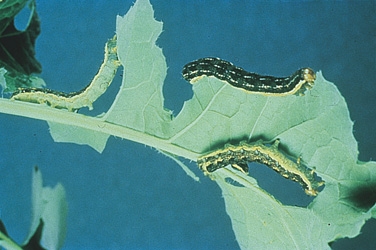
Features
Agronomy
Insect Pests
Bertha armyworm scouting tips
The number of bertha armyworm larvae on a farm last year is not a reliable indicator of what to expect this year. Bertha armyworm populations fluctuate widely from year to year.
Provincial monitoring programs raise awareness of potential outbreaks, based on number of adult moths caught in pheromone traps. Adult counts in June and July can indicate the risk of larvae feeding in July and August. Begin larval monitoring after peak flowering or about two weeks after peak trap catches. Continue scouting until either the mean number of larvae per square foot exceeds the economic threshold (at which point the crop is sprayed) or until the time remaining until the crop is swathed no longer allows for application of a registered insecticide based on the allowed pre-harvest interval.
Often bertha larvae aren't noticed until they move up the canopy and are easily visible during mid to late podding. At this point, chewing on the pods causes visible yield loss quickly. They will lower in canopy before that time, feeding on lower leaves. Assessing your crop early for telltale signs of leaf feeding and becoming aware of your forecast risk will give producers time to accurately assess and time an insecticide application, if needed.
Scouting tips
— Go out in early morning or late evening when larvae are mostly active.
— Mark out an area a quarter-metre square (50 cm by 50 cm) and beat the plants growing within that area to dislodge the larvae. Count the larvae that have fallen to the ground and multiply by 4 to get the number per metre square. Larvae will hide under leaf litter and in cracks, so check closely.
— Sample at least 5 locations (10-15 is recommended) a minimum of 50 metres apart. Do not sample headlands and areas within the crop that are not representative of the field. Use the average number of larvae at the sites surveyed to determine if the economic threshold has been exceeded.
— Scout each field. Adjacent fields may have very different larval densities, depending on how attractive the crop was when the moths were laying their eggs. Adjacent fields may also have different-sized larvae, depending on when the eggs were laid.
— For best results, apply an insecticide as soon as economic thresholds are reached. A single well-timed application of any registered insecticide is usually effective. Check provincial crop protection guides for registered insecticides.
— Apply insecticides early in the morning or late evening when the larvae are actively feeding. Do not apply during warm afternoons.
Click here to see a video of Alberta Agriculture and Rural Development's insect management specialist, Scott Meers, demonstrating how to scout for Bertha armyworm larvae in the field.
May 31, 2017 By Canola Council of Canada
 Begin larval monitoring after peak flowering or about two weeks after peak trap catches.
Begin larval monitoring after peak flowering or about two weeks after peak trap catches.